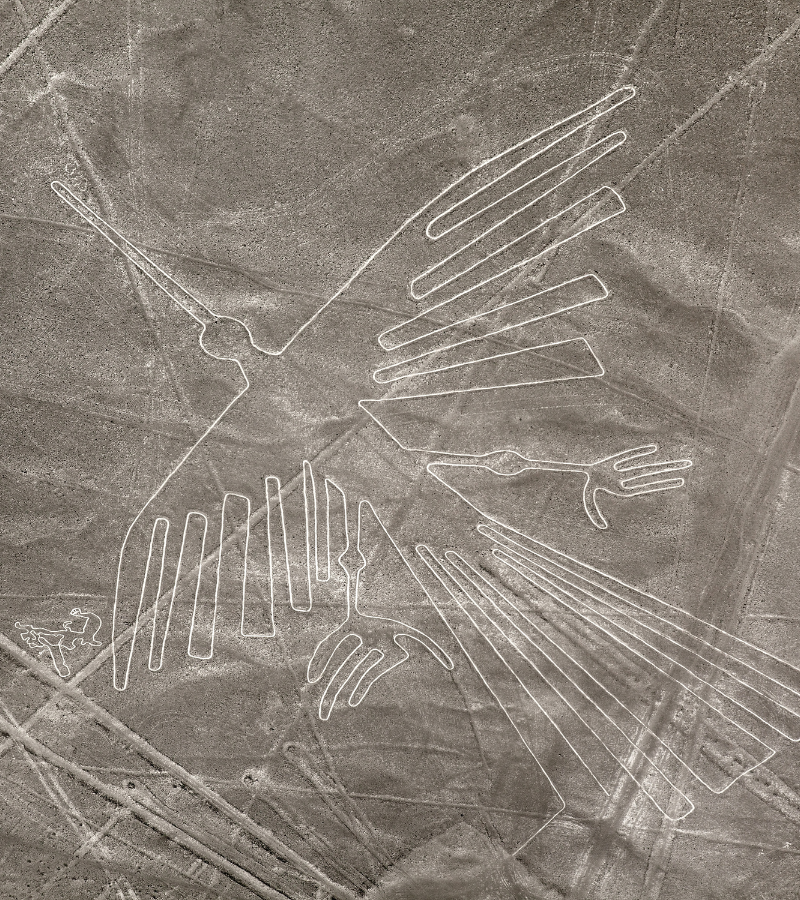


Cusco , Machu Picchu , Lima , Nazca Lines .
The best time to visit the Nazca Lines is between May and October, during the dry season, when the skies are clearer and the chances of turbulence are minimal. These months provide the best flying conditions, allowing travelers to fully appreciate the mysterious geoglyphs from above. Although daytime temperatures can be warm, the stable climate ensures a safer and more enjoyable flight experience.
The most popular tour in Nazca is undoubtedly the flight over the Nazca Lines, where travelers can marvel at enormous geoglyphs like the hummingbird, monkey, spider, and condor. Other tours include visits to the Cantalloc aqueducts, an ancient water system built by the Nazca culture, and the Chauchilla Cemetery, which showcases pre-Inca burials and artifacts. Many itineraries also combine Nazca with destinations like Paracas or Ica for a complete desert-coast experience.
In Nazca, there are plenty of things to do beyond the iconic overflight. Visitors can explore local museums to learn about the Nazca culture, hike to viewpoints for a ground perspective of some geoglyphs, or visit the desert landscapes that surround the city. Exploring the aqueducts and archaeological sites provides insight into the ingenuity of this ancient civilization, while stargazing in the desert offers a unique, magical experience under clear skies.
The climate in Nazca is generally hot and dry, with average daytime temperatures around 25–30°C. Nights are cooler, especially in the winter months of June and July. Rain is extremely rare, making Nazca a year-round destination, although the dry season from May to October remains the most recommended period for clear skies and comfortable conditions.
The closest airport serving Nazca is Maria Reiche Neuman Airport, which is primarily used for overflights of the Nazca Lines. For domestic and international flights, travelers usually fly into Jorge Chávez International Airport in Lima or Capitán FAP Renán Elías Olivera Airport in Pisco, continuing by bus or private transport to Nazca. Many tour operators include transportation from Lima or Ica as part of the experience.
Nazca offers a variety of accommodations, from budget-friendly hostels to comfortable mid-range hotels and boutique stays with desert views. Many hotels cater specifically to travelers coming for the flights, offering flexible schedules and convenient services. Some accommodations also include pools and gardens, making them a relaxing retreat after exploring the desert and archaeological sites.
Restaurants in Nazca feature a blend of traditional Peruvian flavors and coastal-influenced dishes. Fresh seafood, ceviche, and Andean staples like quinoa and corn are commonly found on menus. Visitors can enjoy casual dining in local eateries, try street food specialties, or dine in restaurants offering panoramic views of the desert. The combination of coastal and Andean influences makes the food scene in Nazca unique and flavorful.
Most businesses in Nazca accept credit and debit cards, though small restaurants, markets, or local tour operators may prefer cash. ATMs are available in town, but carrying some soles is always practical, especially for minor expenses or tips. It is advisable to withdraw cash in larger cities like Lima or Ica before arriving to avoid any inconvenience.
Festivities in Nazca often celebrate the cultural and historical heritage of the region. Local events include traditional dances, music, and parades, often held in honor of patron saints or agricultural cycles. While not as widely known as other Peruvian festivals, these celebrations provide an intimate glimpse into the traditions of the Nazca people and their connection to the desert environment.
Nazca is world-renowned for its mysterious geoglyphs, massive designs etched into the desert floor by the Nazca culture over 1,500 years ago. Their exact purpose remains unknown, though theories suggest astronomical, religious, or agricultural significance. The town itself serves as a hub for exploring the desert, offering archaeological sites, museums, and cultural experiences that shed light on one of Peru’s most enigmatic civilizations.
Top places to visit in Nazca include the Nazca Lines, Cantalloc aqueducts, Chauchilla Cemetery, and Cerro Blanco, one of the tallest sand dunes in the world. The Antonini Archaeological Museum also provides valuable context on the Nazca culture. Together, these sites reveal both the mystery and the ingenuity of the ancient Nazca people, making this destination an unforgettable stop on Peru’s southern coast.

We're flexible! Postpone your tour with zero cost up to 10 days prior to departure.